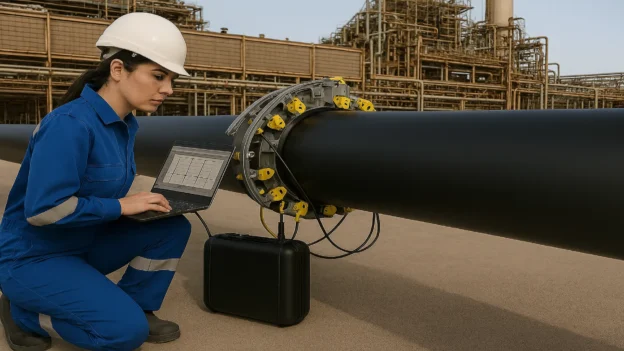Table of Contents
- Why inspect HDPE pipes
- Principles of guided wave ultrasound
- Research and technical validation
- Laboratory results on HDPE pipes
- Influence of crack geometry and orientation
- Numerical modeling and projections
- Advantages over other techniques
- Challenges in HDPE pipe inspection
- Continuous monitoring and predictive maintenance
- Applicable regulations and standards
- Future prospects
- Conclusion
- References
- Frequently Asked Questions (FAQs)
HDPE pipes (high-density polyethylene), are essential in water, gas, and chemical networks thanks to their corrosion resistance, flexibility, and long service life. However, they can suffer from cracks and invisible defects caused by operational stresses or aggressive environments.
Guided wave ultrasound is an advanced technique that inspects long distances from a single point, detecting damage early on. Integrated with continuous monitoring, it helps prevent incidents, optimize maintenance, and improve infrastructure safety, ensuring reliable and long-lasting pipe operation.
Why inspect HDPE pipes
Although high-density polyethylene is a reliable material, it is not immune to failure. Its widespread use in natural gas and drinking water networks means that undetected damage can lead to dangerous leaks, prolonged service outages, and environmental damage.
The main causes of failure include:
- Mechanical damage during installation or maintenance work.
- Structural fatigue due to repetitive internal pressures.
- Chemical degradation due to exposure to UV radiation, hydrocarbons, or other agents.
- Ground movements and differential settlements that generate stresses.
Regular inspections not only help detect these problems before they become serious, but also allow for preventive maintenance planning, reducing costs and extending the service life of the pipes.
Principles of guided wave ultrasound
Guided Wave Ultrasonic Testing (GWUT) is a non-destructive inspection method that uses transducers to generate low-frequency mechanical waves. These waves travel along the pipe, confined by its geometry, allowing large sections to be evaluated from a single point.
Unlike conventional ultrasound, which only examines small areas, GWUT analyzes pipe lengths that can exceed tens of meters, detecting signal alterations caused by cracks, corrosion, or deformations.
In polyethylene pipes, attenuation is higher than in metal pipes, so selecting the appropriate mode and frequency is critical. Recent research indicates that modes L(0.3) at 35 kHz and L(0.4) at 50 kHz offer the best balance between range and sensitivity.
Research and technical validation
Studies such as that by Shah, El-Hawwat, and Wang (2023) have demonstrated, through laboratory testing and finite element numerical modeling, that GWUT is effective in detecting cracks in polyethylene pipes outside welded joints.
Key findings include:
- Reliable detection of cracks whose length is equal to or greater than the wavelength used.
- Greater sensitivity with the pitch & catch method compared to the echo mode.
- Range limitations due to the high attenuation of HDPE.
Meanwhile, research such as that by Lowe et al. highlights the importance of optimizing transducer array design and adjusting the center frequency to increase detection capability in plastic materials.
Laboratory results on HDPE pipes
In controlled environments, cracks of different dimensions and orientations were manufactured to evaluate the response of GWUT in polyethylene pipes. The most relevant findings are:
- Cracks whose length is similar to or exceeds the wavelength are more easily detected.
- The L(0.4) mode at 50 kHz is more sensitive to small defects, but with greater signal loss over long distances.
- The L(0.3) mode at 35 kHz achieves better signal stability and greater range.
- Orientation is decisive: cracks perpendicular to propagation generate greater attenuation, while axial cracks require torsional modes for detection.
Influence of crack geometry and orientation
The interaction between the wave and the crack depends on its shape, size, and arrangement:
- Depth: greater depth equals greater amplitude reduction.
- Length: Long cracks generate signals that are easier to identify.
- Orientation: Longitudinal cracks can go unnoticed with longitudinal modes, so it is key to combine modes to maximize coverage.
These factors highlight the need to adapt inspection parameters to each specific case.
Numerical modeling and projections
Modeling with ABAQUS made it possible to reproduce the actual conditions of wave propagation in HDPE and validate the experimental data. In addition, it facilitated:
- Simulation of scenarios that are impossible to generate physically.
- Analysis of the behavior of different combinations of modes and frequencies.
- Optimization of inspection strategies based on reliable predictions.
This approach reduces research time and costs, while improving the accuracy of maintenance programs.
Advantages over other techniques
Guided wave ultrasound offers significant benefits over other inspection methods such as visual inspection, radiography, or thermography:
- Long-distance coverage without the need for multiple access points.
- Non-destructive, preserving the integrity of the pipeline.
- Versatility for buried, overhead, or hard-to-reach pipes.
- Early detection that prevents critical failures.
- Integration with continuous monitoring for real-time tracking.
- Economic efficiency by reducing excavations and downtime.
Challenges in HDPE pipe inspection
Despite its advantages, GWUT faces certain challenges in HDPE:
- Limited coupling due to the low rigidity of the material.
- High attenuation, which reduces the effective range.
- Anisotropy in mechanical properties depending on the direction of the material.
- Need for specialized personnel for accurate data interpretation.
Continuous monitoring and predictive maintenance
The installation of permanent GWUT sensors at strategic points in the network allows for:
- Early detection of structural changes.
- Reduction of unnecessary on-site inspections.
- Planning of interventions based on real data.
- Improved system availability and reliability.
This predictive maintenance model transforms infrastructure management, reducing costs and increasing operational safety. Figure shows two data analyst engineers collecting and processing information as part of the HDPE pipe inspection plan.

Applicable regulations and standards
It is essential that guided wave ultrasonic testing (GWUT) on HDPE pipes complies with current regulations:
- ISO 18211:2016: Non-destructive testing using GWUT on surface and plant pipes.
ISO 4773:2023: Phased-array AWG method for inaccessible structures, including buried pipes; requires personnel qualified according to ISO 9712.
BS 9690-1 and BS 9690-2 (2011: General guidance and basic requirements for GWUT on pipes (British Standards).
ASTM E2775-16 and E2929-13 – Standard practices for GWUT on elevated steel pipes; although not specific to HDPE, they serve as a technical reference.
In addition, there are specific regulations for HDPE pipes and their joints, which complement the technical context:
- ASTM E3044:2022: Ultrasound for butt fusion joints in polyethylene pipes.
- ASTM E3170:2018: Phased-array testing on electrofusion joints.
- ISO TS 16943 and ISO TS 22499: Inspection of electrical and butt joints in polyethylene pipes using phased array.
- ASME BPV III, Appendix XXVI : Requirements for buried HDPE Class 3 installations, including ultrasonic testing. Wikipedia+15polytestsystem.com+15IFANPLUS Pipe Fittings Manufacturer+15
Finally, for HDPE pipes in Europe, standards such as the following stand out:
- EN 12201, European standard for physical, chemical, environmental properties, and quality of HDPE pipes.
- ASTM D3035, D3350, F1041, D1598, D1599, F2164, specifications for material, pressure testing, leakage, and recyclability.
These standards ensure that inspection procedures are technically valid and comply with safety, quality, and industrial certification criteria.
Future prospects
The development of guided wave ultrasound in HDPE pipes continues to advance in controlled research and testing environments. Trends emerging for large-scale implementation include:
- Integration of artificial intelligence for automatic signal analysis and early identification of deterioration patterns.
- Creation of lighter, more flexible sensors that are adaptable to the HDPE surface, improving coupling and reducing attenuation.
- Optimization of mode and frequency combinations to expand the range of detectable defects, including longitudinal and hard-to-reach cracks.
- Development of standardized protocols for field validation, enabling adoption by industry standards and certifications.
Conclusion
Guided wave ultrasound is a highly effective tool for inspecting HDPE and polyethylene pipes, offering accurate detection of damage and corrosion processes before they become critical. Its ability to be integrated into continuous monitoring programs positions it as a key element in modern fluid transport network management.
By combining laboratory testing, numerical modeling, and qualified personnel, GWUT can overcome your current challenges and become the gold standard for non-metallic pipe inspection.
Protect your HDPE pipes today.
Early detection is the key to avoiding costly failures.
References
- JAY SHAH, SAID EL-HAWWAT, HAO WANG. Guided Wave Ultrasonic Testing for Crack Detection in Polyethylene Pipes: Laboratory Experiments and Numerical Modeling; Accessed on October 28, 2023; https://www.mdpi.com/1424-8220/23/11/5131
- PREMESH SHEHAN LOWE, HABIBA LAIS, VEENA PARUCHURI, TAT-HEAN GAN. Application of Ultrasonic Guided Waves for Inspection of High Density Polyethylene Pipe Systems; Accessed on October 27, 2023; https://ouci.dntb.gov.ua/en/works/9GQQJdx4/
Frequently Asked Questions (FAQs)
1. Why is it important to inspect polyethylene pipes? R. Because, although they are strong and durable, they can suffer invisible damage that compromises their performance.
2.What are the advantages of guided wave ultrasound? R. It allows long distances to be inspected from a single point, is non-destructive, and can be integrated into continuous monitoring.
Can all types of cracks be detected? R. It is most effective with cracks perpendicular to the wave, but combining modes expands coverage.
3. How does frequency influence detection? R. High frequencies (50 kHz) detect small defects but with a shorter range; low frequencies (35 kHz) cover more distance with less sensitivity.
4. Can this technique be applied to buried pipes? R. Yes, GWUT is especially useful in hard-to-reach areas, including buried pipes, suspended pipes, or underground crossings.

